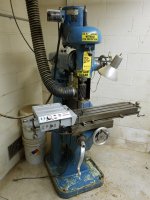mvernon
Plastic
- Joined
- Feb 10, 2019
- Location
- Pennsylvania
Hello all,
I am looking at bidding on this U.S. MACHINE TOOL/MILLRITE MODEL MVN VERTICAL MILL, 1 HP, LYMAN POWER TABLE. It appears it was used in a woodshop and has some sort of cutter "permanently" attached to the spindle. I am not really able to view this in person as it is 2 hours away. Do you think his mill can be returned to an original function machine without a ton of work. I have heard parts for this mills are real easy to find. Also what would be a good price for this as I will be bidding and don't want to over spend.
Thanks for helping out!

I am looking at bidding on this U.S. MACHINE TOOL/MILLRITE MODEL MVN VERTICAL MILL, 1 HP, LYMAN POWER TABLE. It appears it was used in a woodshop and has some sort of cutter "permanently" attached to the spindle. I am not really able to view this in person as it is 2 hours away. Do you think his mill can be returned to an original function machine without a ton of work. I have heard parts for this mills are real easy to find. Also what would be a good price for this as I will be bidding and don't want to over spend.
Thanks for helping out!



